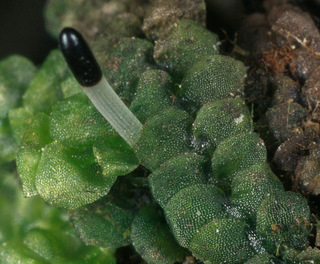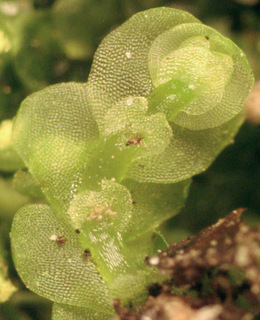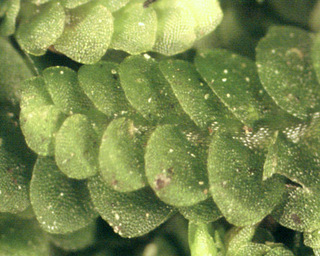Calypogeia
Calypogeia muelleriana
Calypogeia ( German Bart chalice Moose ) is a genus of liverworts in the family Calypogeiaceae.
Features
The pale green to bluish green, trailing or partly ascending plants usually form flat lawn. The overshot (the upper edge of a sheet covers the bottom of the next higher leaf ) edge blades are double-spaced and often densely arranged dachziegelig, the leaf shape is ovate to broadly ovate or triangular, the tip is rounded or shortly bilobed. Lower leaves are always present, they are usually wider than the stems, about as long as wide at the top and more or less deeply in two parts to undivided. At the base of the leaves is a small cell Rhizoidinitialenfeld, which often arise from numerous rhizoids. The leaf cells are relatively large, thin-walled and have 2 to 13 grape-like, colorless or blue oil body. Spore capsules are cylindrical, but are rarely present. Often, however, greenish heap of one-to two-celled propagules are formed at the tips of upright flagellenartigen drives.
Dissemination
The genus is almost cosmopolitan spread, it is absent in desert areas and in the Arctic.
Systematics and species
Worldwide approximately 35 species can be distinguished. The genus is indeed quite well characterized, but the distinction within the genus of some species is difficult. Of the European species until the early 20th century were only three species differed (C. arguta, C. fissa, C. trichomanis ).
In Germany, Austria and Switzerland, the following species are represented:
- Calypogeia arguta
- Calypogeia azurea
- Calypogeia fissa
- Calypogeia integristipula
- Calypogeia muelleriana
- Calypogeia neesiana
- Calypogeia sphagnicola
- Calypogeia suecica



_6129.JPG/300px-Calypogeia_muelleriana_(b,_144823-474711)_6129.JPG)


